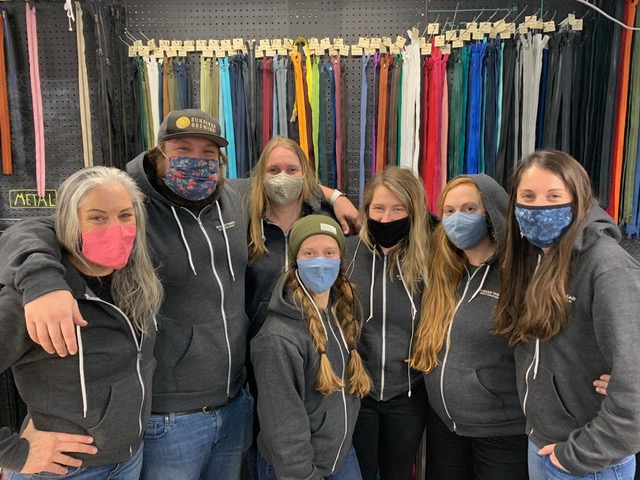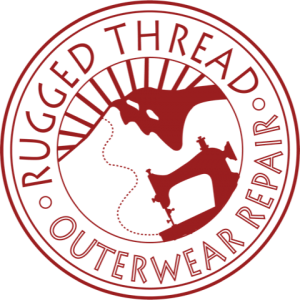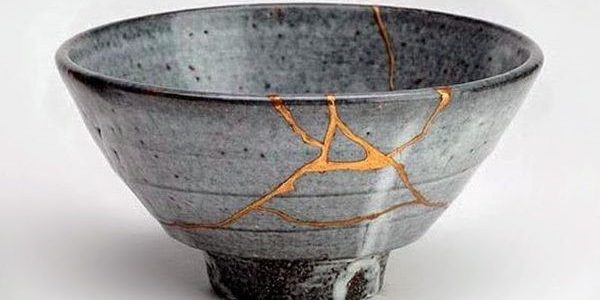Green Spotlight: Rugged Thread

Repair!! It’s the key to a circular economy, y’all. In this day and age with planned obsolescence being the norm for everything from our cell
phones to our appliances to our CLOTHING, we want to use our money to buy quality items that have more durability and combine that with excellent repair options. Never heard of a circular economy? It’s a term coined by the Ellen MacArthur Foundation. It’s kind of like an economist’s phrase for sustainability — moving beyond “take-make-waste” economics. Repair is a crucial puzzle piece for this concept.
I learned about Rugged Thread awhile back and finally got a chance to chat with them about who they are and what they do. I won’t say too much, but they are a super awesome repair-centric business here in Bend, Oregon. Here’s our conversation:
Rethink Waste: Hi! It’s nice to meet you. I’m glad I get a chance to sit down and chat with you about this amazing work you do. To start, tell us about Rugged Thread. Who are you and how did you get started?
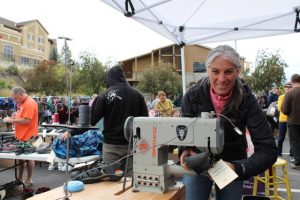
Kim Kinney at an outdoor repair event at REI
Rugged Thread: Our mission is to convert outdoor industry waste into a new economy while creating high-skill, family wage jobs. We repair
all four seasons of technical outdoor clothing and gear from down jackets and outerwear to tents, sleeping bags, motorcycle gear, backpacks, and zippers.
Kim Kinney started the company in 2011 out of her garage; today we have a staff of seven and a commercial space on the eastside of Bend.We are a triple bottom line company committed to environmental sustainability, social responsibility, and economic equity.
As a whole, the Outdoor Repair Economy is a new, emerging industry that has exciting potential. At Rugged Thread, we are exploring ways to make repairs easier through new technologies and collecting data on Design For Repairability so that we can advise brands on best design practices.
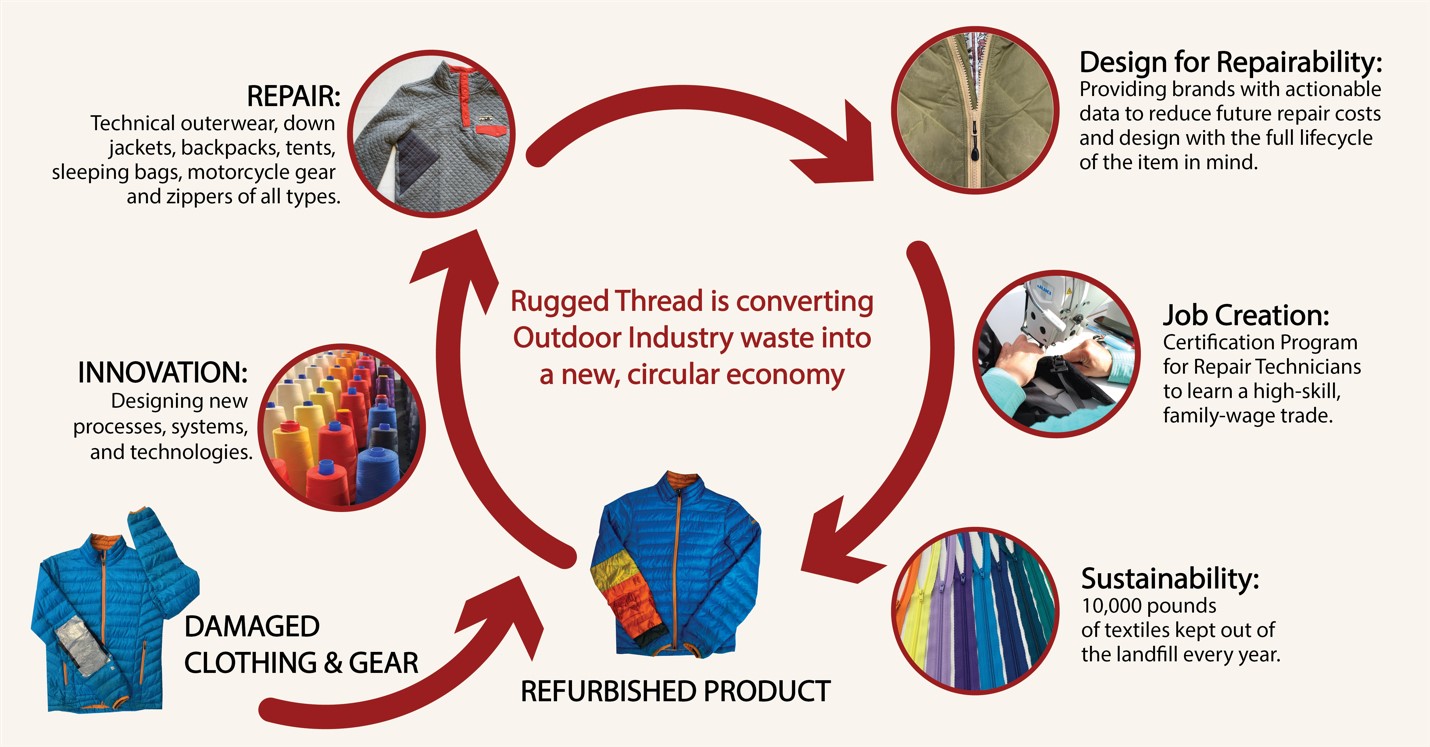
RW: Super cool. Thanks for sharing this graphic. It really helps outline what your business does. So this year, how many garments / pieces of outdoor gear / tents, etc. do you expect to save from disposal?
RT: The unique (and cool!) thing about our business model is that the more we grow, the bigger positive impact we have on the environment and our community. For example, this year we plan to repair about 5,000 items that would otherwise have ended up in the landfill and in 2024, our goal is 20,000 items.
RW: That is great! Sound like lot of pounds of textiles. Speaking of environmental impacts, how do you feel your business model fits in with combatting the ever-growing piles of textile and plastic waste–particularly thinking about our own Deschutes County Knott Landfill, which is projected to be full by 2029?
RT: The U.S. throws “away” 16 million tons of textiles every year —that’s one garbage truck every second! It’s important to remember that outdoor-specific clothing and gear is primarily derived from petrochemicals that take up to 200 years to break down and leach harmful chemicals into our waterways and soils in the meantime. As Patagonia’s Worn Wear Manager Nellie Cohen says, “By and large, the textile industry is the oil industry when it comes to performance materials. Every time you buy a new ski outfit, it’s like filling up your gas tank.”
Simple repairs make a huge difference considering that 64% of textiles that are thrown “away” only have minor damage like a broken zipper, buckle, or small tear. Our goal is to make repairs a cultural norm through increased education, awareness and a shift in mindset. Currently there are very few repair facilities specific to technical outdoor clothing and gear so it still comes as a surprise to many people that high-quality repair is even an option.
RW: That’s a good point about how our clothes are often made of plastic which is made from oil and natural gas. It’s something a lot of folks don’t think about. So then, in what way do you think repair culture has a positive impact on the environment?
RT: We love what repair culture embodies. A damaged item can be an opportunity for customization rather than the end of its lifecycle. Kintsugi, for example, is the Japanese art of repairing broken pottery with powdered precious metals. As a philosophy, it treats breakage and repair as part of the history of an object rather than something to disguise or discard. We want clothes and outdoor gear to be seen like this, too.
At Rugged Thread our long-term vision is to create a national co-op of repair facilities that share knowledge, materials, and overflow work in order to make a meaningful environmental impact. We are also developing a nationally certified training program for repair technicians in an effort to change the stigma of sewing as a career path.
- Example of Kintsugi pottery
- Down vest with patch from Rugged Thread
RW: Ok you even make repairs look cool — like a badge of honor! I like it. Do you think repair is a scalable, sustainable, circular business model? If so, in what way(s)?
RT: Absolutely! Today’s clothing industry (and arguably most industries) are built on a linear model of take-make-dispose, without considering the full lifecycle of the products. We believe the only way for the textile industry and Outdoor Industry to be successful long-term is to create a closed-loop, circular economy. Simply put, we live in a world with finite resources and “business as usual” must change.
Repairs play an integral role in creating a circular economy and go beyond recycling. Simply extending the life of a garment by 9 months reduces its environmental impact by 20-30%. It also reduces over-extraction of raw materials, overproduction, and overconsumption.
It is exciting to see brands think about the full lifecycle of their products and commit to repairing. For example, we work with Burton Snowboards, Trew Gear, and Gossamer Gear, among others, to repair rather than replace products covered under warranty. Then there are brands like Patagonia, REI, and Arc’teryx that have started buy-back programs in which they clean, repair, and re-sell used items at a discount. By 2024, the second-hand market is expected to overtake the traditional retail market at $36 billion. Within the next five years, we expect to see brands, manufacturers and individuals embrace repairs in a big way.
RW: Great. Well thank you for the education and insight. I hope you reach that 20,000 goal in 2024! I’m going to help by bringing some of my broken zippers down to you for fixing.
